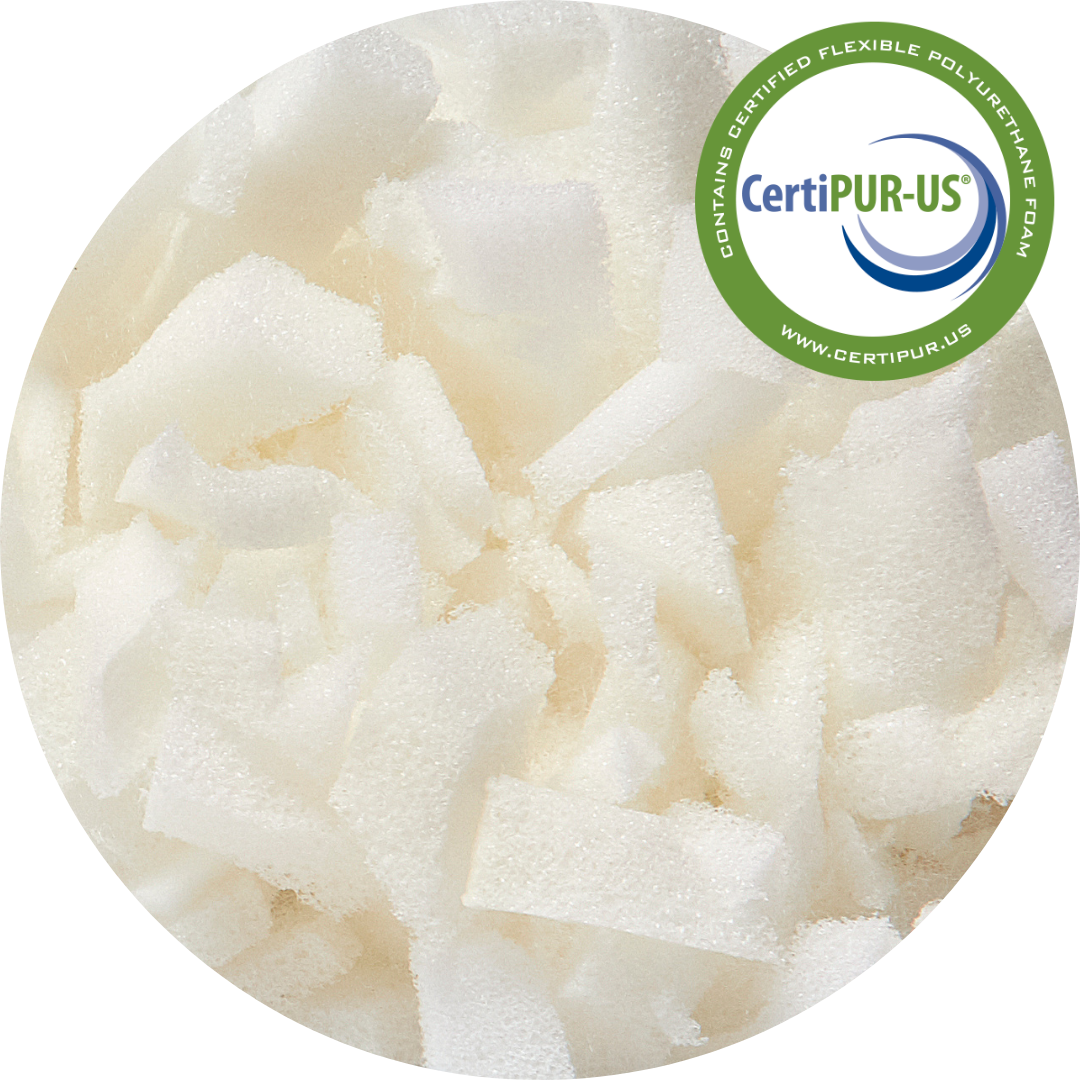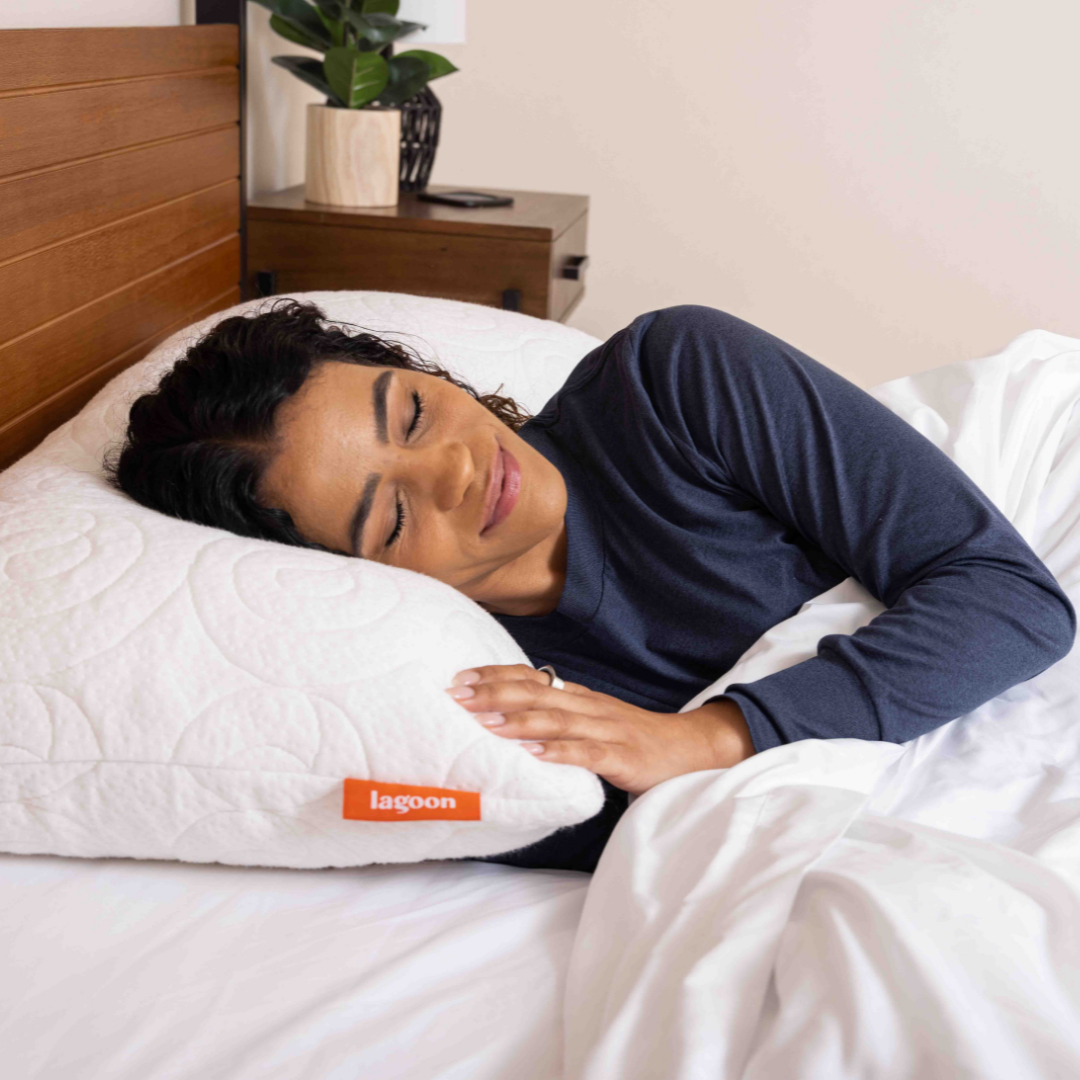What’s your pillow made out of? It’s a question that a majority of people don’t know the answer to; however, knowing and adapting accordingly can have a huge impact on how well you’re sleeping through the night. Here’s an in depth look at the construction of a pillow — from fill, to liner, to cover —to tell you everything you need to know about what’s in a pillow, and why it matters.
The Fill
Memory Foam
One of the most common fill materials in bed pillows is memory foam. Best known for its prominent role in mattresses, memory foams can have a wide range of softer to firmer types. In general for pillows though, it’s known for providing more support and greater consistency than other materials.
Quality Standards: The internationally recognized seal for quality memory foam is the CertiPUR US certification. This seal ensures that the memory foam you’re buying is made without ozone depleters, mercury, lead, formaldehyde and other materials that may be bad for the environment, and the process for making the foam has low emissions.

Molded Memory Foam: The ‘traditional’ memory foam pillow is of the molded variety - in a bread loaf, specialized (i.e. curved neck support), or even cube shape.
Takeaway: Consider this type of pillow if you like firmer support (i.e. resting your head on top of the pillow) with a consistent feel; typically best for side sleepers
Try the Hippo

Shredded Memory Foam: A relatively new entrant to the scene, shredded memory foam is a softer alternative to its molded cousin. Quality shredded foam pillows may be blended with poly fibers to help bind the pieces of memory foam to help with consistency and prevent clumping.
Takeaway: Consider shredded memory foam if you want a pillow that’s going to last longer and provide more support than feather or fiber filled pillows; typically best for versatile sleepers (side, back, and rotating sleep positions)
Try the Fox
Down Alternative
Another great fill option for pillows is down alternative fibers. Typically these fibers are made from polyester and can have a variety of different densities (softness) and longevity. Make sure you know what type of fibers are in your pillow to nail the feel and the lifespan of your pillow.

Microfibers: Typically microfibers will be your softest material. These fibers are very fine — as much as 1/100th the diameter of a human hair — and about one-third the diameter of a cotton fiber. Microfibers are a synthetic polyester - which some people prefer rather than animal-derived materials - but others are leary of for sustainability reasons. It’s becoming more any more common practice for suppliers to use recycled poly to up-cycle synthetics.
Takeaway: Consider a microfiber pillow if softness is a higher priority for you than support. These pillows are typically best for stomach sleepers.
Try the Puffin
Other Natural Materials
There’s a wide variety of natural or recycled materials that are used to construct bed pillows, making for a more sustainable ecosystem. Be weary though of the processes being used to procure these materials and and claims that brands use which may seem suspect.

Australian Wool: Lately Australian wool has become a popular choice for (attire and) bed pillow (thanks Allbirds!), due to its surprisingly soft texture and breathability.
Takeaway: A great natural option for those sleepers who prioritize sustainability; however, wool still won’t be as soft as many microfibers, or even shredded memory foam, so it’s a trade off for you to consider. Typically best for back sleepers.
Try the Koala

Bamboo: Some brands are now making bamboo into fibers to fill your pillow. You may see bamboo fibers solo or blended with recycled fibers for a bit more support and longevity. Bamboo is great because it really is such a soft and sustainable material.
Takeaway: Give bamboo a try and see if it’s what works best for you. It’ll typically be a pretty neutral or balanced fill - with both medium support and softness. Good for back or side sleepers.
Try the Lemur
Feather: The classic feather pillow. It’s what bed pillows started out as. Typically feathers will either be plucked from geese or ducks. The higher end alternative to feather would be “down” material, which is the softer variety of feather from the animal’s chest area. The rub with feathers or down is that they are taken off the animal - however, some brands do claim to responsibly source these materials with industry standards.
Takeaway: Some people just like the luxury of feather and down materials. If this classic pillow is best for you, stick with what works - just make sure no ducks were harmed in the process ;)
Latex: This material is extracted from a rubber tree. Latex is a popular material for use in a pillow because it's durable and supportive. It will not collapse under the weight of your head like softer pillow; however, it may have a slightly ‘bouncier’ feel to it.
Takeaway: Try latex if you are looking for a natural alternative to molded memory foam.
The Liner
The first layer that holds the fill of a pillow is considered the liner. Some pillows only have a liner but not a shell, and in this scenario the liner will need to be made of more durable materials. For those pillows that have a separate shell, the liner is typically intended to be “holder” and should ideally be quite breathable. The two most common types of liners are constructed of either cotton or polyester. Often times, it’s better to have a lower thread count, which means that air can circulate through this layer, rather than getting trapped in it.
The Shell
Finally you have the pillow shell, which is the outermost layer of the pillow. It’s typically made of materials that are very soft to the touch, like bamboo, tencel, cotton, poly or a blend of these materials. A good shell should be hypoallergenic (ensuring that germs and mites aren’t getting into the inner pillow) and durable (so it can be washed regularly). While you could theoretically sleep on a shell directly, most people still put a linen or cotton pillow case on top of their shell.
So there you have it - all the components of the bed pillow. If you have any questions, don’t hesitate to reach out at hello@lagoonsleep.com. We’re here to help ensure that sleep-seekers have the information they need to get their best sleep.
Looking for a new pillow and still unsure which one is right for you? Take Lagoon's pillow quiz to find out.








